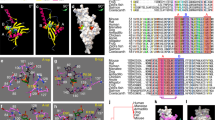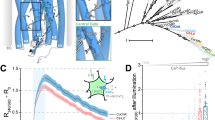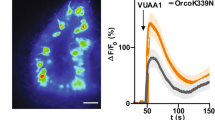Abstract
OLFACTORY receptor neurons depolarize in response to odorant stimulation of their sensory cilia1–3. One transduction mechanism involves a G-protein-mediated increase in adenylate cyclase activity4–8, raising the internal cyclic AMP concentration to open a cyclic nucleotide-activated cation channel on the plasma membrane9–14. An influx of Ca2+ through this channel, which is permeable to both monovalent and divalent cations, triggers olfactory adaptation15. Previous work has indicated that at least part of this Ca2+ -mediated adaptation resides in the channel itself15–17, but the mechanism remains unclear and controversial16–18. Here we use the cloned channel from rat19 expressed in a cell line and the native channel from rat olfactory receptor cells to show that Ca2+ reduces the apparent affinity of the channel for cAMP by up to 20-fold in the presence of calmodulin, an abundant protein in olfactory cilia20. This decrease in apparent affinity appears to involve a direct interaction between Ca2+–calmodulin and the channel, and it can reduce the activation of the channel by cAMP by up to a few hundred-fold, suggesting that it may be a key component of the Ca2+ -triggered olfactory adaptation.
This is a preview of subscription content, access via your institution
Access options
Subscribe to this journal
Receive 51 print issues and online access
$199.00 per year
only $3.90 per issue
Buy this article
- Purchase on Springer Link
- Instant access to full article PDF
Prices may be subject to local taxes which are calculated during checkout
Similar content being viewed by others
References
Firestein, S. & Werblin, F. Science 244, 79–82 (1989).
Kurahashi, T. J. Physiol., Lond. 419, 177–192 (1989).
Lowe, G. & Gold, G. H. J. Physiol., Lond. 442, 147–168 (1991).
Pace, U., Hanski, E., Salomon, Y. & Lancet, D. Nature 316, 255–258 (1985).
Sklar, P. B., Anholt, R. R. H. & Snyder, S. H. J. biol. Chem. 261, 15538–15543 (1986).
Jones, D. T. & Reed, R. R. Science 244, 790–795 (1989).
Bakalyar, H. A. & Reed, R. R. Science 250, 1403–1406 (1990).
Boekhoff, I., Tareilus, E., Strotmann, J. & Breer, H. EMBO J. 9, 2453–2458 (1990).
Nakamura, T. & Gold, G. H. Nature 325, 442–444 (1987).
Kurahashi, T. J. Physiol., Lond. 430, 355–371 (1990).
Firestein, S., Darrow, B. & Shepherd, G. M. Neuron 6, 825–835 (1991).
Frings, S. & Lindemann, B. J. gen. Physiol. 97, 1–16 (1991).
Frings, S., Lynch, J. W. & Lindemann, B. J. gen. Physiol. 100, 45–67 (1992).
Lowe, G. & Gold, G. H. J. Physiol., Lond. 462, 175–196 (1993).
Kurahashi, T. & Shibuya, T. Brain Res. 515, 261–268 (1990).
Kramer, R. H. & Siegelbaum, S. A. Neuron 9, 897–906 (1992).
Zufall, F., Shepherd, G. M. & Firestein, S. Proc. R. Soc. Lond. B246, 225–230 (1991).
Kleene, S. J. J. Membr. Biol. 131, 237–243 (1993).
Dhallan, R. S., Yau, K.-W., Schrader, K. A. & Reed, R. R. Nature 347, 184–187 (1990).
Anholt, R. R. H. & Rivers, A. M. Biochemistry 29, 4049–4054 (1990).
Chen, T.-Y. et al. Nature 362, 764–767 (1993).
Hsu, Y.-T. & Molday, R. S. Nature 361, 76–79 (1992).
Klee, C. B. & Vanaman, T. C. Adv. Prot. Chem. 35, 213–321 (1982).
Jaworsky, D. E., Matsuzaki, O., Borisy-Rudin, F. F. & Ronnett, G. V. J. Neurosci (in the press).
Borisy, F. F. et al. J. Neurosci. 12, 915–923 (1992).
Kurahashi, T. & Yau, K.-W. Nature 363, 71–74 (1993).
Lowe, G., & Gold, G. H. Nature 366, 283–286 (1993).
Kleene, S. J. & Gesteland, R. C. J. Neurosci. 11, 3624–3629 (1991).
Kleene, S. J. Br. J. Pharmac. 111, 469–472 (1994).
Bradley, J., Uezono, Y., Davidson, N. & Lester, H. Soc. Neurosci. Abstr. 18, 596 (1992).
Liman, E. R. & Buck, L. B. Biophys. J. 66, A350 (1994).
Author information
Authors and Affiliations
Rights and permissions
About this article
Cite this article
Chen, TY., Yau, KW. Direct modulation by Ca2+–calmodulin of cyclic nucleotide-activated channel of rat olfactory receptor neurons. Nature 368, 545–548 (1994). https://doi.org/10.1038/368545a0
Received:
Accepted:
Issue Date:
DOI: https://doi.org/10.1038/368545a0
This article is cited by
-
Intranasal sodium citrate in quantitative and qualitative olfactory dysfunction: results from a prospective, controlled trial of prolonged use in 60 patients
European Archives of Oto-Rhino-Laryngology (2021)
-
The cyclic AMP signaling pathway in the rodent main olfactory system
Cell and Tissue Research (2021)
-
26Al/10Be Burial Dating of the Middle Pleistocene Yiyuan Hominin Fossil Site, Shandong Province, Northern China
Scientific Reports (2019)
-
The extraordinary AFD thermosensor of C. elegans
Pflügers Archiv - European Journal of Physiology (2018)
-
Contribution of the cyclic nucleotide gated channel subunit, CNG-3, to olfactory plasticity in Caenorhabditis elegans
Scientific Reports (2017)
Comments
By submitting a comment you agree to abide by our Terms and Community Guidelines. If you find something abusive or that does not comply with our terms or guidelines please flag it as inappropriate.



